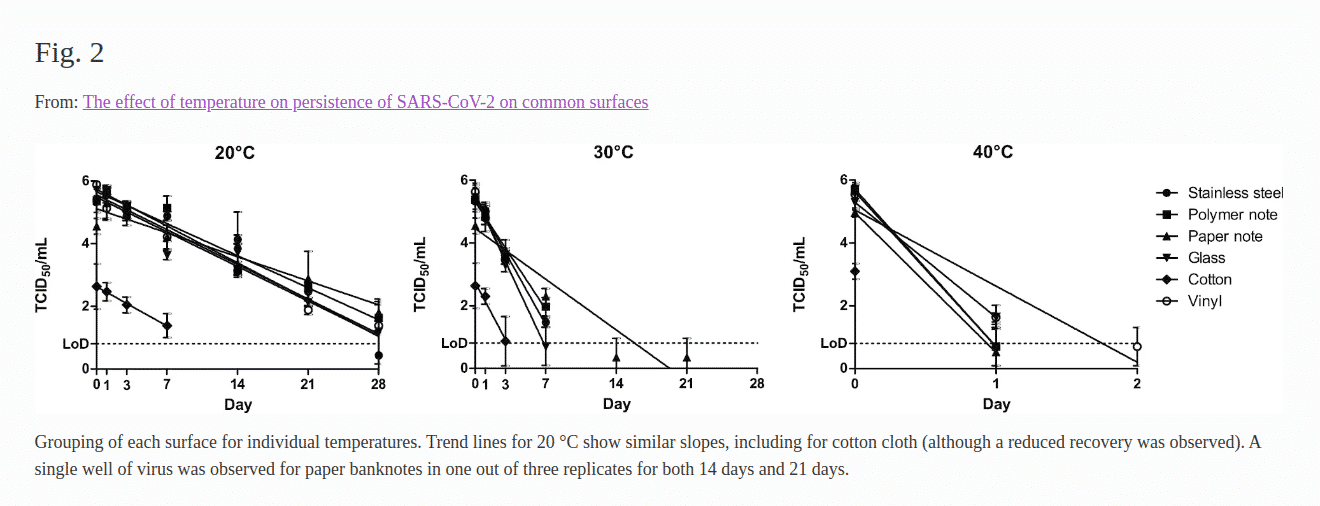 From Forbes Oct2020 — Article quotes new Australian research study on the effect of temperature on persistence of SARS-CoV-2 on common surfaces such as stainless steel, paper, glass, cotton, vinyl and polymer. The main point is that surfaces which are relatively cool are going to be more prone to harboring infection. 68 degrees F is comfortable for the virus and extends to 28 days. 86 degrees knocks the lifespan down to 2 days.
From Forbes Oct2020 — Article quotes new Australian research study on the effect of temperature on persistence of SARS-CoV-2 on common surfaces such as stainless steel, paper, glass, cotton, vinyl and polymer. The main point is that surfaces which are relatively cool are going to be more prone to harboring infection. 68 degrees F is comfortable for the virus and extends to 28 days. 86 degrees knocks the lifespan down to 2 days.
Several publications jumped on this report but for some reason singled out cash as the primary focus. That is probably good for clicks and traffic but not informative and educational as primary. For us the bottomline is first priority is clean your mobile phone.
Before we get to the Forbes excerpt here are some comments by Matt Sykes PhD
“COVID remains on banknotes for 28 days” – it’s a great headline, isn’t it? A pity the news article so poorly represents the research and pragmatic considerations. For example:
– The research is in lab conditions. Highly controlled. Exactly as it should have been for research, but not representative of the every day. For example, it doesn’t seek to account for higher temperatures in wallets/purses
– 28 days is the time for 100% certainty of the virus being gone. However, at 20 degrees, 90% is gone in around 6 days; at 30 degrees, 90% is gone in 2 days
– The experiment was at a constant 50% humidity (again, the right decision for research). Depending on where you are in Australia, you’ll have humidity closer to 60-70%, which reduces the life of the virus
– It is now commonplace for retail staff and consumers to hand sanitise before and after using cash, which clearly makes practical risk much lower, and will likely impact on the life of the virus on a note (hand sanitiser wiping on notes through touch)
It is frustrating and unfortunate that a publication such as the The Australian Financial Review runs to sensationalism. Great to have research, but interpret it correctly!
PM me if you want more details on interpreting the research.
Excerpt from Forbes
The novel coronavirus can remain infectious for four weeks on banknotes, according to new research by the Australian Centre for Disease Preparedness, Australia’s top biosecurity laboratory.
These findings reinforce the importance of hand-washing or using disinfecting hand sanitizer after visiting an ATM or handling cash.
The researchers tested how long the coronavirus survived on both paper and polymer banknotes at various temperatures. They found that the coronavirus can survive “to at least 28 days” on both types of banknotes, which is significantly longer than the seasonal flu virus’s “demonstrated survival up to 17 days” at room temperature (20 degrees Celsius or 68 degrees Fahrenheit).
The Centers for Disease Control and Prevention’s guidance on running essential errands recommends using online banking and touchless payment options when possible, and includes several relevant pieces of advice:
- “Use drive-thru banking services, automated teller machines (ATM), or mobile banking apps for routine transactions that do not require face-to-face assistance as much as possible.”
- “Use hand sanitizer containing at least 60% alcohol after any deposit, withdrawal, exchange, drive-thru visit, or use of an ATM.
Excerpt From The Study
The persistence of virus on both paper and polymer currency is of particular significance, considering the frequency of circulation and the potential for transfer of viable virus both between individuals and geographic locations. While other studies have shown that paper notes harbour more pathogens than polymer notes [38], this data demonstrates that SARS-CoV-2 persists on both paper notes and polymer notes to at least 28 days at 20 °C, albeit with a faster rate of inactivation on polymer notes. Data presented in this study for banknotes is significantly longer than reported for other respiratory viruses such as Influenza A (H3N2) which demonstrated survival up to 17 days at room temperature [39]. It is also noted that prior to SARS-Cov-2 being declared a pandemic, China had commenced decontamination of its paper based currency, suggesting concerns over transmission via paper banknotes existed at the time [40, 41]. The United States and South Korea have also quarantined bank notes as a result of the pandemic [42, 43]. It is important to note that after 28 days, infectious SARS-CoV-2 was also recovered from stainless steel, vinyl and glass, suggesting survivability on paper or polymer banknotes was not very different from the other non-porous surfaces studied.
The persistence on glass is an important finding, given that touchscreen devices such as mobile phones, bank ATMs, supermarket self-serve checkouts and airport check-in kiosks are high touch surfaces which may not be regularly cleaned and therefore pose a transmission risk of SARS-CoV-2. It has been demonstrated that mobile phones can harbour pathogens responsible for nosocomial transmission [44], and unlike hands, are not regularly cleaned [45]. The data presented in this study correlates well with previously published data for Influenza A (H1N1) which recovered infectious virus up to 22 days at 22 °C and 7 days at 35 °C [37]. The persistence of SARS-COV-2 on glass and vinyl (both common screen and screen protector materials, suggest that touchscreen devices may provide a potential source of transmission, and should regularly be disinfected especially in multi-user environments.
